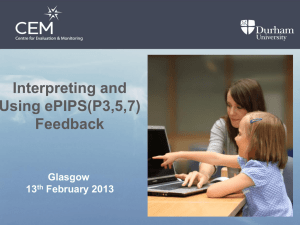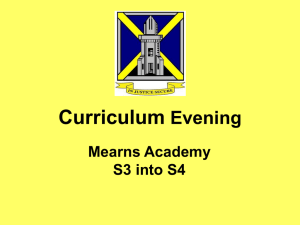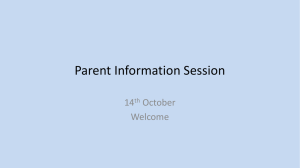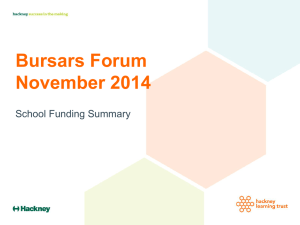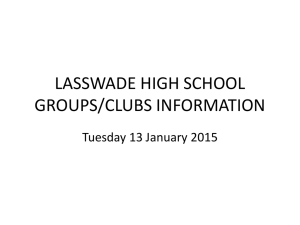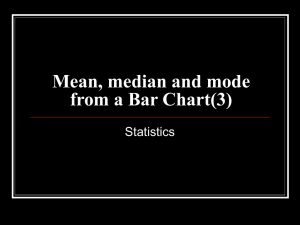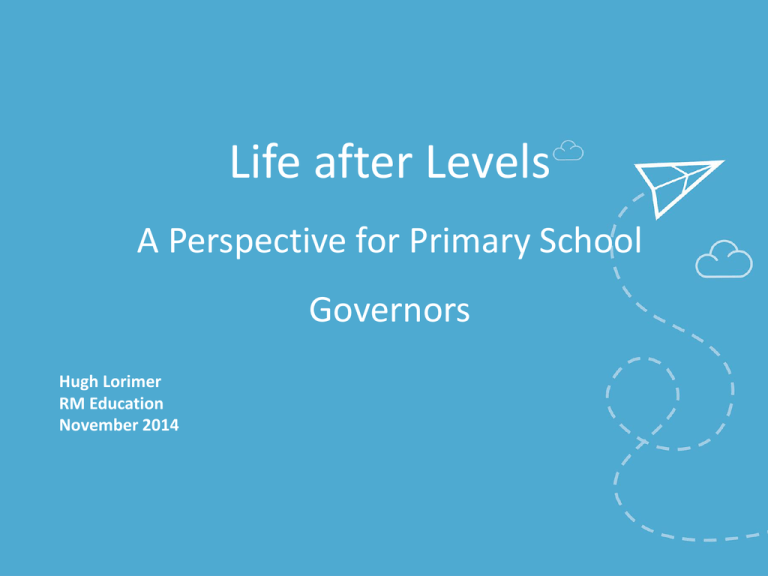
Life after Levels
A Perspective for Primary School
Governors
Hugh Lorimer
RM Education
November 2014
Life after Levels
A guide to the new National Curriculum and associated
assessments for school governors.
– A look at the new National Curriculum
– Current statutory assessment system
– New statutory assessment system
– Performance Descriptors
– Measuring progress in schools
– Transition arrangements
– Key discussion points
What does it look like?
•
Covers Years 1-11
– In Primary Schools it covers years 1-6.
– Divided into Key Stage 1 & 2 as at present.
•
Primary Subjects
– Core Subjects
• English, Maths & Science
– Foundation Subjects
• Art & Design, Computing, Design & Technology, Languages (KS2 only),
Geography, History, Music, Physical Education
– Other Compulsory Subjects
• Religious Education
•
Secondary Variations
– Citizenship and Sex & RE compulsory in KS3 & 4
– Computing compulsory through to KS4.
– All other Foundation subjects optional in KS4
Structure of National Curriculum
Core Subjects are also subdivided with, generally, a separate definition for
each National Curriculum Year
English
Maths
Science
Spelling
Reading &
Writing
Year 1
P
P
P
P
Year 2
P
P
P
P
Year 3
P
P
Year 4
P
P
P
P
Year 5
P
P
Year 6
P
P
P
P
Spoken
Language
P
Core Subjects
English is subdivided as follows:
– Spoken Language (a small section that covers Y1-6)
– Reading
• Word Reading
• Comprehension
– Writing
• Transcription
• Composition
• Writing, Grammar & Punctuation
– Spelling
Core Subjects
Maths is subdivided – varies by year
– Number
• Number & Place Value
• Addition & Subtraction
• Multiplication & Division
• Fractions
– Measurement
– Geometry
• Properties of Shape
• Position & Direction
– Statistics (from Year 2)
– Ratio & Proportion (Year 6 only)
– Algebra (Year 6 only)
Core Subjects
Science is subdivided – varies by year
– Year 1
• Working Scientifically
• Plants
• Animals, including humans
• Everyday changes
• Seasonal Changes
– Year 6
• Living things and their habitats
• Animals including humans
• Evolution and inheritance
• Light
• Electricity
Core Subject Example
Year 1 Maths
– Number
• number and place value
By the end of each year, pupils are
expected to know, apply and
understand the matters, skills and
processes specified
Foundation Subject Example - Geography
NB. Much smaller definitions that just
cover the two key stages.
Introducing the New Curriculum
From September 2015
– All Subjects in all years will be taught using the new curriculum
• English, Maths, Science and all foundation subjects
– New Statutory Assessments in summer 2016.
• English and Maths
For 2014/15 only
Year 2
– Teach the old curriculum for English, Maths and Science.
– New curriculum compulsory for foundation subjects.
– Assessment in 2015 at end of KS1 based on old curriculum.
Year 6
– Teach the old curriculum for English, Maths and Science.
– New curriculum optional for foundation subjects.
– Assessment in 2015 at end of KS2 based on old curriculum.
Years 1,3,4 & 5
– From Sept 2014 it has been compulsory to teach new NC
to years 1,3,4 & 5.
Statutory Assessments
• Are taken at the end of Years 2 and 6
• Apply from Summer 2016
• Early Years assessments are important, though not
part of the new National Curriculum.
• We will look at
– Current Assessment System
– New Statutory Assessments
Current Assessment System
Early Years
– Teacher Assessment at end of Reception Year to see if pupils
have achieved a Good Level of Development in each of 17
aspects.
Key Stage 1
– Teacher assessments in Reading, Writing, Speaking & Listening,
Maths and Science. These are informed by internal tests.
Key Stage 2
– Tests in Maths, Reading and GPS (grammar, punctuation and
spelling)
– Teacher Assessment for Writing
– Science Tests in some schools – not reported.
Assessment and Progress
Over next few years we will move towards a system
that is based on:
• An assessment of pupils ability at start of Reception
• An assessment of pupils ability at end of Year 6
• The progress made by pupils between start of Reception and
end of Year 6
• Whether pupils are at the national standard at the end of Year
6 (i.e. are ‘Secondary Ready’)
New Assessment System
Reception Baseline
• A short assessment of pupils that will be a good predictor of KS1 and KS2
attainment.
• Principle use is for checking on progress at a school level
• Taken within pupil’s first few weeks at school (in Reception Year)
• From September 2015 schools will be able to choose an approved baseline
assessment (available from suppliers) that will sit within the assessments
that teachers make of children during reception.
– Details awaited.
– The Baseline Assessment is Optional
• Progress Measures for a School will rely entirely on the Baseline Data for
pupils starting Reception in September 2016 and after.
– So School Progress Measures in 2023 will depend on decisions taken in 2016
New Assessment System
Early Years
– From September 2016 the Early Years Foundation Stage
Profile will no longer be compulsory.
– The Early Years Foundation Stage will continue to be
statutory.
Phonics Test
– The phonics check near the end of Year 1 is being retained
– With the ability to retake in Year 2 if required.
End of Key Stage Assessments
Assessment Methods and Reporting
• Tests will be externally set and marked either internally or
externally.
• At end of KS2 the results will be reported as a Scaled Score
where meeting the standard is awarded a score of 100 or
above.
• Teacher Assessments will be based on Performance
Descriptors (PD).
– In some cases there is just one PD for a subject (‘meets national
standard’)
– While in other cases there are 4 or 5 such as ‘Working Towards the
National Standard’ and ‘Working at a Mastery Standard’
New Assessment System – KS1
Externally set &
marked
Speaking &
Listening TA
Teacher
Assessments
Externally set Internally
marked
GPS Test
Reading Test
Maths Test
Writing TA
Reading TA
Maths TA
•Mastery Standard
•National Standard
•Working towards
•Mastery Standard
•National Standard
•Working towards
•Mastery Standard
•National Standard
•Working towards
national standard
national standard
national standard
•Below national
standard
•Below national
standard
Science TA
•Working at the
national standard
•Below national
standard
Performance
Descriptors
New Assessment System – KS2
Externally set &
marked
GPS Test
Reading Test
Maths Test
100 = Standard
Scaled Score
Scaled Score
Scaled Score
Teacher
Assessments
Writing TA
•Mastery Standard
•Above National
Reading TA
•Working at the
national standard
Maths TA
•Working at the
national standard
Science TA
•Working at the
national standard
Standard
•National Standard
•Working towards
national standard
•Below national
standard
Performance
Descriptors
Performance Descriptors
• To support teachers in making effective and consistent
assessments of their pupils’ attainment, performance
descriptors have been drafted for these subjects.
(English, Maths & Science)
• These set out the performance of pupils at the end of key
stages 1 and 2. Where applicable, teacher assessment
will also be informed by the outcomes of the statutory
end of key stage tests.
From the October 2014 DfE Consultation Document
Performance Descriptors
e.g. KS1 Maths – Pupils working at national standard
Performance Descriptors
e.g. Maths – Number and place value
Working below national standard
Pupils working towards national standard
Pupils working at national standard
Pupils working at mastery standard
How will schools be measured?
In Reading, Writing and Maths at end of KS2
– NB Student Expected Standard = requires both of
• Achieve a scaled score of 100 plus
• Teacher Assessment as ‘At National Standard’ or above
Floor Standard
– This is the standard that the School is expected to meet. School is
deemed to meet this
– If:
• More than 85% of pupils achieve the new expected standard
– Or:
• Pupils make sufficient progress from their Baseline
– There are rule variations for Junior, Middle and First schools.
Floor Standard before 2023
• Prior to 2023 the following methods will be used to
determine if a school meets its Floor Standard
• Until Year 6 pupils can have a Baseline in place (2022
or 2023) the progress measure will be based on
progress from KS1 assessments to KS2 assessments.
– From 2016 to 2019 this will be based on existing KS1
assessment system
– from 2020 this will be based on new KS1
assessments.
How Can Schools Ensure Good Progress?
• Classroom teachers will be concerned to make
sure that they:
– Teach the assigned curriculum
– Know what their pupils can and cannot do
– Plan teaching to cover the things that their Pupils
need to cover
• Classroom teachers will also be required to report
on this to
– pupils
– parents
– management
Teacher’s Perspective
Formative Assessment – In the Classroom
– Assessment in the classroom against a detailed list of
objectives.
– Objectives generally based on National Curriculum
and NAHT Objectives.
– Schools are able to devise their own system.
– Teachers can assess each objective at various levels:
e.g. Beginning, Working Towards, Met
– Some systems also allow teacher to record if a pupil
has ‘more than met’ each objective.
– Some systems encourage teachers to record when
each objective is achieved (e.g. Year 1 Spring Term)
Management Perspective
Summative Assessment
Provide an overview of each student and of groups
of students
• Typically recording whether pupil is secure in the work for
their Year Group.
• In order to record progress need to record one or more ‘steps’
prior to being secure.
• For pupils who are secure before the end of the year:
– Record some steps beyond secure (e.g. ‘Excelling’, ‘Mastery Standard’ )
– Or move on to the next year’ curriculum
Monitoring Progress – Within a Year
Progress can be monitored within a School Year
– Typically a pupil will start the Year at the first step for that year and by
the end of the year will be at least secure for that Year.
• Some pupils will not be secure by the end of the year
• Some pupils will be beyond secure
• Example
– John starts Year 3 at first step for that year
– During the year we need to check that John is making sufficient
progress such that they will be secure in the work for Year 3 by the
end of the year.
– To do this teachers may do one or more of:
• Regularly count up objectives that John is secure in
• Regularly assess a step or stage that John has reached in the subject (e.g.
emerging, developing, secure, excelling) and plot this against John’s expected
progress path.
Monitoring Progress – Between Years
Progress can be monitored from one School Year to the
next:
– A pupil who is secure at end of one year may be expected to be
secure at the end of the following year.
– A pupil who is excelling at the end of one year would be
expected to be excelling at the end of the next year
Schools can plot the progress of each pupil to detect pupils who
are not making as much progress as their previous assessment
data suggests.
For example if Jane was recorded as Exceptional at the end of Year 2,
and Excelling at the end of Year 3 but is only Secure at the end of Year
4 the school would want to find out why
What are Ofsted Looking For?
Inspectors will:
•
•
•
•
•
spend more time looking at a range of pupils’ work in order to consider what progress they
are making in different areas of the curriculum
talk to leaders about the school’s use of formative and summative assessment and how this
improves teaching and raises achievement
evaluate how well pupils are doing against age-related expectations, as set out by the school
and the National Curriculum (where this applies)
consider how the school uses assessment information to identify pupils who are falling
behind in their learning or who need additional support to reach their full potential, including
the most able
evaluate the way the school reports to parents on pupils’ progress and attainment.
Inspectors will assess whether reports help parents to understand how their children are
doing in relation to the standards expected.
(extract from letter to schools from Ofsted – July 2014)
Clarification
Ofsted does not expect performance- and pupil-tracking data to be
presented in a particular format. Such data should be provided to
inspectors in the format that the school would ordinarily use to track
and monitor the progress of pupils in that school.
(Clarification from Ofsted October 2014 )
Key Discussion Points
• To what extent and detail should teachers be recording
achievement in the classroom?
• What scale should be used for recording detailed achievement?
• Should teachers record when pupils achieve each objective?
• How should Formative Assessment feed into Summative
Assessment? Automatic? Termly?
• What scale (points, steps,stages) should be used to record pupil
attainment each term (or half term)? E.g. Beginning Year N,
Working Towards Year N, Secure at Year N, Exceeding, Exceptional
etc
• Should Pupils move on to curriculum for the Year ahead of their
National Curriculum Year?
In Summary
•
•
•
•
There is a lot of work going on in schools
There is still a lot of confusion
Teachers need time to put formative systems in place
SLT, Governors need to work with Teachers to put
summative systems in place that will enable them to
monitor progress – without overloading the teachers

